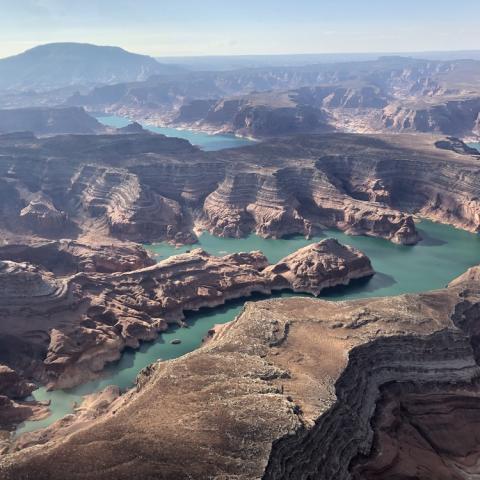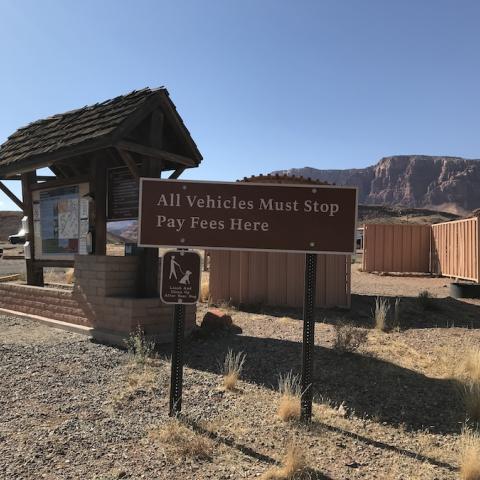
High-flow releases at Glen Canyon Dam are meant to mimic the natural flooding of the Colorado River/NPS
As the National Park Service works to determine how the Glen Canyon Dam along the Colorado River operates for the next 20 years, a new study commissioned by the Glen Canyon Institute says halting hydropower generation at the site would have little impact on the western power grid.
The report, The Impact of the Loss of Electric Generation at Glen Canyon Dam, was released last month and prepared by Power Consulting. It summarizes that “if Glen Canyon Dam stopped generating hydropower, it would have a negligible impact on the western power grid, would raise electric rates by an average of 8 cents per month for residential customers of hydropower, and could save tens of millions of dollars each year in taxpayer subsidies and water lost to system inefficiencies.”
The dam, completed 50 years ago, is a key cog in a complex system to allocate water to seven states in the Colorado River basin but has been lamented by conservationists since its approval. To allocate water and electricity, the reservoir, Lake Powell, flooded what the Glen Canyon Institute describes as “a wonderland of spires, gorges, cliffs, and grottoes.” The lake stores water that is drawn on in times of drought, upstream from Hoover Dam and its reservoir, Lake Mead. Secondarily, the Glen Canyon Dam annually produces around 5 billion kilowatt-hours of hydroelectric power, which is distributed by the Western Area Power Administration.
“Our study investigated the claim by water and power managers that the loss of hydropower generation at Glen Canyon Dam would have catastrophic impacts on the customers that currently get at least some of their electricity from the dam,” said Dr. Thomas Power, principal at Power Consulting and a research professor and professor emeritus in the University of Montana Department of Economics. “Based on an exhaustive review of the data, we found this claim to be largely inaccurate. A small subset of customers would experience a significant rate increase, but for the vast majority, the increase would be minuscule.”
The key findings of the report:
- The average annual value of Glen Canyon Dam’s electric energy represents less than one half of 1 percent of the sales value from electric generation in the western grid, and that the grid could readily absorb the loss of hydropower from the dam.
- The total impacts would be an increase of $16.31 million in electricity costs for consumers of Glen Canyon Dam power, but because they would be spread among 3.2 million customers, the individual impacts would be small in the vast majority of cases.
- The average annual value of the Glen Canyon Dam electric energy is $153.3 million. This value is less than one half of one percent of the close to $31 billion in sales value from electric generation in the Western Electricity Coordinating Council.
- Average yearly cost increases would be $.08 per month for residential customers, $.59 per month for commercial customers, and $6.16 per month for industrial customers of Glen Canyon Dam electricity.
- A discontinuation of Glen Canyon Dam operations could have offsetting benefits of approximately $74.8 million annually, including savings of $34.9 million in management costs and potential earnings of as much as $39.8 million annually due to increased hydropower at Hoover Dam and conservation of water that would have otherwise seeped into the banks of Lake Powell.
Earlier this year, the National Park Service took comments on a draft environmental impact statement on how to operate the dam for the next 20 years, and none of the alternatives called for removing the dam. At 710 feet, the Glen Canyon Dam is the second-tallest concrete-arch dam in the United States (just 16 feet short of Hoover Dam). Although Lake Powell was at 3,620 feet (80 feet from full pool) in June, the level was expected to drop going into fall and winter. In recent years, parts of Glen Canyon National Recreation Area have been closed due to low water levels, which are expected to worsen.
Daniel Beard, a former commissioner of the U.S. Bureau of Reclamation, wrote a book on why the Glen Canyon Dam should be decommissioned. In Deadbeat Dams: Why We Should Abolish the U.S. Bureau of Reclamation and Tear Down Glen Canyon Dam, published last year, Beard argues that “the current state of affairs at Glen Canyon Dam leads me to conclude that we should remove Glen Canyon Dam, drain Lake Powell, and allow the Colorado River to fill Lake Mead behind Hoover Dam.”
The Glen Canyon Institute, a nonprofit dedicated to restoring a free-flowing river through Glen Canyon, agrees that Lake Mead should be filled first, with Lake Powell as a backup.
“This study debunks another major rationale for the argument that we need to maintain the status quo at Glen Canyon Dam and Lake Powell to ensure the integrity of the Colorado River system,” said Eric Balken, executive director of Glen Canyon Institute. “The Power team’s analysis shows that even if Lake Powell were completely drained, the loss of hydropower would have a minimal impact on the vast majority of consumers of this power. For the small number of consumers who would experience a greater impact, such as Native American utilities, we believe there are viable strategies for offsetting any rate increase.”
The research was reviewed by an independent panel of economists: David Marcus, Gail Blattenberger, and Spencer Phillips.



 Support Essential Coverage of Essential Places
Support Essential Coverage of Essential Places







Comments
Removing the Glen Canyon Dam would be one of the most naive decisions that we could make. You're talking not only losing a renewable energy source but also recreational value of Lake Powell and the water storage capacity that goes with it. While the Colorado River Basin is currently in a prolonged drought and water levels are low, there will certainly be plenty of wet periods where the lake will be useful, even with climate change and overdraw factored in.
Lake Powell, Lake Mead, and all the other reservoirs along the lower Colorado evaporate about 6 inches of water off every square foot every day in summer. That's enough water lost to evaporation to supply the needs of both Las Vegas and Los Angeles for a day.
In addition, all the evaporation increases water salinity to the point where water used for irrigation in the area of Yuma is actually beginning to have adverse effects upon soil quality in irrigated fields.
The downside of Glen Canyon Dam was recognized years ago--and only now acknowledged in the current drought. Probably the first step will be to draw Lake Powell down and restore the dwindling levels of Lake Mead. Then, should a wet period return, the dam would still be in place for further storage--and power.
No matter, the evaporation rates are horrendous, along with seepage into porous sandstones. It was never a good place for a dam.
Likely we will be saying the same thing years from now about all of the wind and solar projects we are putting up. Live and learn? Not when there is a gold rush, of which Glen Canyon Dam was one of the last big projects in the era of reclamation. TVA nailed the door shut in the middle South. A free-flowing river? What good is that? Great expanses of open space? What good are they?
We still think we are so smart that we can remake the world--up to and including correcting our own mistakes. There is the cause of climate change, good people--arrogance. But yes, I am glad to see Edward Abbey proven right.
After reading "Running Dry, a Journey from Source to Sea Down the Colorado River" by Jonathan Waterman, I have traveled to many of the areas in the west to see for myself what he describes, and it is clear the salinity of the water taken from the river and/or stored there is
raising in salinity to an alarming degree. Spending time in Yuma is an education of what not to do in agriculture. The winter lettuce crop is followed by cotton. Not a healthy scenario for salad lovers! Robotic machines are now being developed to spray sulfuric acid on the unwated lettuce sprouts for thinning the rows....the seeds are all sprouted with precious water and are killed instead of being havested as "baby lettuce" or donated. Our agriculteral system is as crazy as the water distruibution in the west. "Cadillac Desert" written in the '80's is prophetic of our current issues....citizens should read and act according to these two informative books about the west and its water. I live in the midwest and we primarily grow hog food, corn and soybeans...when we could grow nearly all our human food, and of course lettuce! When we grow our food nearby with our plentiful water, we could allow the western rivers once more to flow more freely and enjoy the wilderness once described by Powell and Muir. Plentiful agricultural workers or robots, both can be utilized with careful planning and legislation...and curtail subsidies when they contravene nature's principles.
What about the 9.4 billion lb of CO2 it saves vs coal. What about tourist dollars, bald eagles, and how lake mead needs this dam during prolong droughts. I guess I could keep going but clearly the author didn't do enough research. Or he/she was played
Yeah evaporation, it would be better not to have any dams, let all the fresh colorado river water run into the Sea of Cortez and become useless salt water. Good Idea!
I would replace the dam with huge natural gas power plant. The water itself should be sent to the ocean where it belongs. Humans be dammed, how dare they try to control mother nature this way, give up your crops and farming, stop having babies, stop trying to make things better. God gave us a perfect world not to be touched. The ancient Anasazi faced with 30 year drought did not build a dam dam, they had the right idea to just leave everything behind and either embrance death or move to greener pastures, who are we to try to be better than them?!?
Establishing "The Glen Canyon National Bunjie Jump" is the clear solution to the dilmemma of this dam. If precipitation trends continue (and they certainly will), the sooner we drain Lake Powell into Mead, the sooner we start saving precious water from evaporation, rather than maintaining a shallow, putrid pool clogged with mud and driftwood. Now is the time to admit that humans made a big mistake with Glen Canyon Dam and start draining, rather than exacerbating the human-made problems of the Colorado River. The treasures of this placid canyon that would reappear may eventually heal themselves, creating a new type of tourist economy that would rival that of the Grand Canyon. Just look at the pictures from The Place No One Knew: https://openlibrary.org/books/OL5883683M/The_place_no_one_knew